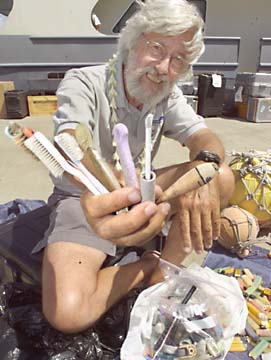
DENNIS ODA / DODA@STARBULLETIN.COM
Jean-Michel Cousteau showed yesterday some of the plastic debris he collected from the beaches of the Northwestern Hawaiian Islands.
Washed-up rubbish
stuns CousteauThe explorer says the islands beyond
Kauai badly need protection
Jean-Michel Cousteau knew when he left for the Northwestern Hawaiian Islands last month that reefs teeming with monk seals, green sea turtles, Galapagos sharks and ulua weren't all he would see there.
He knew there would also be rubbish. He just wasn't prepared for the volume of it.
"There are a few places where you cannot walk without stepping on some of this," Cousteau said yesterday, gesturing at a pile of plastic waste he brought back from the islands and atolls that extend 1,200 miles north of Kauai.
The trash included buoys, floaters, artificial bait, light sticks, toothbrushes, golf balls, razor handles, shoe soles and toys. It comes from the entire Pacific Rim, brought by currents and washed ashore on uninhabited islands that make up the Hawaiian Islands National Wildlife Refuge.
"There are millions of these," Cousteau said, holding up a butane lighter.
Much of the plastic trash is eaten by Laysan and blackfoot albatrosses. Many of them die, he said.
"It's devastating," Cousteau said at the Honolulu Community College Marine Education and Training Center on Sand Island. "In 58 years on the ocean, I have never seen so much debris."
Cousteau, 65, is the son of the late Jacques Cousteau and heads the nonprofit Ocean Futures Society, which carries on the Cousteau legacy of exploring and caring for the ocean.
He hopes that his documentary "Voyage to Kure," which will air on public television stations in 2004, will stimulate interest in protecting the Northwestern Hawaiian Islands.
The waters between the islands have been a federal ecosystem reserve since 2001 and could become the country's largest national marine sanctuary.
"This is one of very few places that does not need to be restored, but needs to be protected," Cousteau said.
Though he has dived in spots all over the world, Cousteau was impressed with the variety of undersea life he saw since leaving Honolulu on July 6 for the voyage to Kure and back.
Cousteau said he hopes to have volunteers clear Laysan Island of plastic debris and then measure how long it takes it to come back. That's if the Fish and Wildlife Service, which has jurisdiction over the islands, agrees.
Cousteau and 19 team members made the 32-day trip on the Searcher, a 96-foot research vessel owned by the Honolulu-based Medical Foundation for the Study of the Environment.
Waimanalo resident Marcus James said he came out to meet Cousteau yesterday because they share a passion for ridding the world's beaches of junk.
"It's not just in the Northwestern Hawaiian Islands," he said. "It's on the windward side of all our islands."
For more information about the Ocean Futures Society, visit www.oceanfutures.org.
